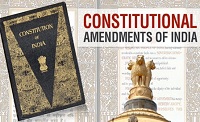Amendment Procedure of Constitution of India- PDF | Procedure of Amendment in Indian Constitution
Dear Readers,
In this post, we are discussing Amendments of India Constitution with complete details. This is very important for upcoming examination, such as ,SSC, RRB, HSSC etc. generally many question were asked from Constitution amendments of India.
The constitution of India also provides amendment in order to adjust itself to the changing condition and needs. This is neither easy as of Britain Constitution and nor difficult as in the case of USA constitution.
- The constitution of India is neither flexible or nor rigid but a combination of both.
- Part XX contains only one Article 368 which describe that Parliament has power to make amend in Constitution Except the Basic Structure of Constitution.
- The procedure of amendment in Indian Constitution is borrowed from South Africa Constitution.

Procedure for Amendment In Constitution
(i). The Amendment in Constitution can be started only by introducing of Bill by minister or a private member(Member of Parliament) in either House of Parliament and does not require prior permission of President for presenting it.
(ii). The bill must be passed in each house by majority of the total membership and a majority of 2/3 of members of the House present and voting.
(iii). The bill must be passed by each house separately, In case, there is a disagreement between the two house,then there is no provision of joint sitting of the two house for the passage of the bill except of legislative bill.
(iv). If the bill tries to amend the federal provisions(relations between center and state government), then it must be passed by the legislature of half of the states by simple majority.
(v). After duly passed by both house of parliament and approved by the state legislature, the bill is presented to the president for assent.
(vi). The president must give assent to the bill, he can neither withhold his assent to the bill and nor return the bill for reconsideration of the parliament.
(vii). After the president assent, the bill becomes an constitutional Amendment.
Types of Amendments
Article 368 provides of Indian Constitution provides for two types of amendment , that is by special majority of parliament and also through ratification of half of the states by Simple Majority, But some other article provide for the amendment of certain provisions of constitution by Simple Majority
Amendment in Indian Constitution can be done in three ways
Amendment By Special Majority of Parliament
As per Article 368, It is a majority of 2/3 members of present and voting supported by 50 % of total strength(Absolute Majority) of the house. For example , strength of Rajya Sabha is 245, absolute majority is 123 + 2/3 of present and voting
The following provisions which can be amended by this way includes Fundamental rights, and Directive Principle of State Policy.
Amendment by Special Majority of Parliament and Consent of states
Provisions which are related to the federal structure of the polity can be amended by a special majority of parliament and also with the consent of half of the state legislature by simple majority, there is no time limit within which the states should give their assent to the bill.
Provisions that can be amended in this Way
=>Election of President
=>Distribution of powers between Union and States.
=>Executive power of the Union and States.
=>Supreme Court and High Court.
=>Representation of states in Parliament.
=>Any of the list in 7th Schedule.
Amendment by simple Majority of Parliament
A numbers of provision can be amended by simple majority of two house of Parliament outside the scope of Article 368.
Provisions which can be amended in this way
=>Admission and abolition of New States.
=>Formation of new states , changes to the boundaries and names of existing states.
=>Abolition and creation of legislative council in States.
=>Quorum in Parliament.
=>Second Scedule
=>Salary and allowances of member of Parliament.
=>Rules of Procedure in Parliament.
=>Acquisition and termination of Citizenship.
=>Election to State Legislatures and Parliament.
=>Use of Official Language.
=>Use of English Language in parliament.
=>Delimitation of Constituencies.
=>Union Territories.
=>5th(Administration of Schedules Areas and Scheduled Tribes) and 6th Schedule(Administration of Tribal Areas).
Types of Majority
There are three types of majority In India Constitution.
Simple Majority
It refers to majority of more than fifty percent of the member of the legislature present and voting.this majority is also known as ” Working Majority” Example , Government of India introduced a bill in Lok Sabha on a day present member in Lok Sabha on that day is 502, suppose two candidate denied to vote for the bill, then we should have assent of 1/2*500+1 members of Lok Sabha.
Where Simple Majority is used ?
=>It is used for the removal of Vice President in Lok Sabha.
=>Resolution passed by the Rajya Sabha should be approved by the Lok sabha with a simple majority.
=>It is also used for the proclamation of financial emergency and for revoking of National Emergency.
=>Vote of thanks to president or governor.
Effective Majority
It is a majority of more than 50% of all then members of the house , The vacant are not taken for the consideration of effective majority.
Where Effective Majority is used ?
=> It is used for the removal of Vice President of India in Rajya Sabha.
=>It is also used for the removal of deputy chairman of Rajya Sabha
=> It is used for the removal of Speaker and Deputy Speaker of Lok Sabha.
Absolute Majority
It is a majority of more than 50% of all members of the House. Example , current strength of Lok Sabha is 545, we should have assent of 545/2 =273 members for passing of bill.
Where Absolute Majority is used ?
=> It is used in elections for the party to prove its majority.
Download Amendment Procedure of Constitution of India PDF
Read more articles….
